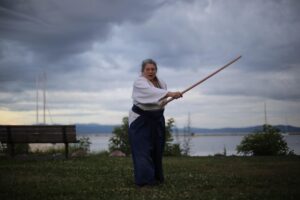15 Jan AIKIDO AND PSYCHOTHERAPY: THE BEAUTY AND BRILLIANCE OF THE SOUL
The idea that we are completely responsible for our own lives, what happens to us, and our states of being is a sticking point for many people, and as I made my way into the world of spiritual expression, it was for me as well. As a child of activists, I know that poverty, inequality, injustice and violence and the lack dignity and respect for all people create suffering and unrealized potential. As a psychologist, I know that these assaults on the soul of humanity are part of the mosaic of pain people bring to me in the hopes of healing.
As a psychologist, I know that early trauma creates suffering and unrealized potential. I know that part of healing is helping my patients to recognize their own goodness and innocence in the face these profound injuries. And in helping them to find that goodness, I help them to find happiness, connection, and a sense of empowerment. A life informed but not driven by past trauma and current adversity. My aspiration is to help my patients find strength, meaning and wisdom in the suffering they have experienced. Strength, meaning and wisdom that can be shared with the world if they so choose.
I aspire to help my patients realize that external circumstances do not in fact define them. That they are here on this planet to define themselves, to develop a sense of efficacy and to have a positive impact. To find inner strength. To look in the mirror, see reflected there the truth of their own brilliance, and step out of the darkness.
 My practice of aikido helps me to realize this aspiration. When our partner (uke) attacks, we can see her as a suffering human being, rather than an aggressor, thus seeing ourselves as a protector, rather than a victim. If we see our partner as suffering, we can also see the best in them. The practice becomes an act of compassion and transformation. The practice becomes a way to help our partner heal from whatever has caused this suffering, rather than a way to defend ourselves. The practice becomes a practice of connection, rather than a practice of separation. And healing occurs, always, in the context of connection, in the consulting room, and on the mat. In my experience on the mat, when aikido is working, an extraordinary transformation takes place. Uke starts out with a sincere attack. Focused, intent on the strike. After the redirection by nage, often a throw, uke find themselves on the ground, giggling, joyous, ready to get up and start again. Spiritually, uke and nage are connected, sharing a sense that all is right with the universe. The practice has brought about healing and brought to uke a sense of belonging. When I take a fall from a skilled aikidoist, I am filled with a sense of peace and a feeling of safety and connection. And this is also the goal of trauma work. What I strive to create for my uke, I also strive to create for my clients. This does not happen all at once, and the process as long. Sometimes there is just a glimmer of light, and then darkness falls again. Like Aikido, trauma work is a practice. The practice of finding the Self, the beauty and brilliance of the soul. Over, and over again.
My practice of aikido helps me to realize this aspiration. When our partner (uke) attacks, we can see her as a suffering human being, rather than an aggressor, thus seeing ourselves as a protector, rather than a victim. If we see our partner as suffering, we can also see the best in them. The practice becomes an act of compassion and transformation. The practice becomes a way to help our partner heal from whatever has caused this suffering, rather than a way to defend ourselves. The practice becomes a practice of connection, rather than a practice of separation. And healing occurs, always, in the context of connection, in the consulting room, and on the mat. In my experience on the mat, when aikido is working, an extraordinary transformation takes place. Uke starts out with a sincere attack. Focused, intent on the strike. After the redirection by nage, often a throw, uke find themselves on the ground, giggling, joyous, ready to get up and start again. Spiritually, uke and nage are connected, sharing a sense that all is right with the universe. The practice has brought about healing and brought to uke a sense of belonging. When I take a fall from a skilled aikidoist, I am filled with a sense of peace and a feeling of safety and connection. And this is also the goal of trauma work. What I strive to create for my uke, I also strive to create for my clients. This does not happen all at once, and the process as long. Sometimes there is just a glimmer of light, and then darkness falls again. Like Aikido, trauma work is a practice. The practice of finding the Self, the beauty and brilliance of the soul. Over, and over again.
One does not need buildings, money, power, or status to practice the Art of Peace. Heaven is right here where you are standing, and that is the place to train.
-Morehei Ueshiba, The Art of Peace


